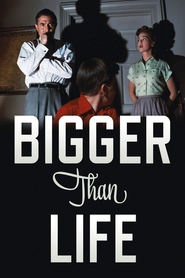
There are many motion pictures that have dwelt in the topic of psychosis and insanity. Whether as social commentary, criminal thrillers or tales of intense horror, insanity has always been used as an interesting plot element used to characterize uncomforting behavior. From the empathetic understanding of Litvak’s, “The snake pit”, to the horrific terror of Hitchcock’s, “Psycho and the stark shocking awareness of Lynch’s, “Mulholland Drive”, the insane have been portrayed in various and extreme contrasting ways. Nicholas Ray’s, “Bigger than Life”, makes this subject its focal point and at first glance appears to be a by the numbers Hollywood film of addiction. After watching the film for the first time I found myself initially entertained but unimpressed. Afterword’s however, I noticed that my mind would keep dwelling on certain attuned aspects of the story. Questions raised by this movie are ones that ask if insanity creates an artificial existence to its bearer or if it actually tears down our forced conformist barriers, allowing its protagonist to behave as he actually is. Quite heady stuff for a family drama made in the 50s. In addition, the film observes some stark criticisms of the American Suburban dream of its time. Something that Sam Mendes did more recently with a more modern version of that dream, in his acclaimed film, “American Beauty”. The film follows schoolteacher and family man Ed Avery (James Mason in a tour de force performance), as he fights to retain his place in the American dream. His British accent only adds to this drive. He works after hours as a taxi dispatcher and hides this job from his wife, so as to not have her feel shame on his working in such a low life 2nd job. He works hard at being an understanding husband to Lou (Barbara Rush) and father to Richie (Christopher Olsen who once again almost ruins the movie with his bad stilted acting). He gets sick with a rare inflammatory, terminal disease and is prescribed a new wonder steroidal drug called cortisone. The new drug cures him of the sickness, but leaves him with a feeling of being all powerful and without fear. Enjoying this feeling, Ed, starts to abuse the drug as he tricks his doctor into increasing his prescription. The added dosage causes him to behave in a psychotic manner. Previous innocent flirtations with a young teacher become glairing intentions. Previous love and care for his pretty wife, become an all controlling urge to run everything about her. The more Ed gets used to this feeling the more he wants it to continue and to get stronger. The movie does a nice job setting up Ed as a crazed man whose eventual murderous and evil transformation places grave danger upon his family. There is one fascinating scene where Ed speaks to parents of his pupils in a PTA meeting, spouting out strong fascist like theories of education, calling childhood a disease and education its cure. Shockingly, we are shown one parent screaming his approval at this disturbing hypothesis. It would seem that fascism had its fans in 1950s America. Those fans were not considered to be crazy. The film has some dark elements of horror sprinkled into its somber showing of a man going insane. At the beginning of the movie there are some subtle hints on what Ed will become and how he actually feels. He feels he must work a 2nd job below his status in order to keep up with what is expected of him from his surroundings but feels pressure to keep it hidden from almost everyone in his life circle. His patient educator treatment of one of his pupils gives off a feeling of deep sarcasm. When he goes Mad those previous hints develop into a mindset that is while Mad, an extension of who he really is. If a madman becomes evil, we ask, mustn’t he have that evil ability within his subconscious in the first place? Does the madness become a nice excuse to breakout from forced inhibitions? These are deep philosophical questions that this fascinating movie develops within its family drama. Ray used widescreen techniques in his shots of the residential interiors that add a dark deep chasm to the home which slowly transforms it into a prison for Lou and Richie. The striking close-ups of Ed that are used to emphasize his growing insanity are quite effective. The ending is a bit of a letdown, but still leaves room for us to wonder if all is good and safe in the sweet suburbia of the white American middle class. Well worth a look, “Bigger than Life,” is not your average Hollywood melodrama.

